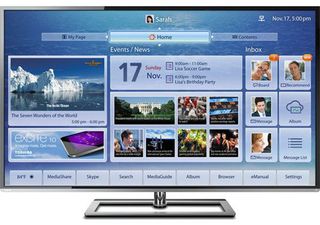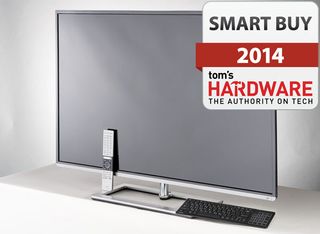Toshiba 50L7300U Review: A 50-Inch LED HDTV With Wi-Fi
You've seen us dramatically increase our display coverage over the last year, and now we're reviewing HDTVs too. Our first screen is Toshiba’s 50-inch L7300U Cloud TV with Wi-Fi. We run it through our lab and usability tests to see how it measures up.
Toshiba's 50-inch Cloud TV Delivers A Lot For The Money
For less than $900, Toshiba delivers tremendous value in the 50L7300U, and in all of its Cloud TVs for that matter. Even if you’re just in the market for a new HDTV and you don’t plan to use the networking-oriented features, this display is a top performer.
HDTVs should be held to the same standards as computer monitors, we think. They should accurately reproduce the Rec. 709 color gamut, achieve a D65 white point at all brightness levels, track a 2.2 gamma value, and deliver excellent contrast. Toshiba checks all of those boxes. While some of the picture modes show oversaturated color and a cool grayscale, the Movie mode is pretty good out of the box. Though we don’t expect many users will pay a professional calibrator to tune a set at this price level, the benefit is worth the expense. We attained a level of accuracy equal to any high-end flat panel or projector thanks to the full color management system and 10-point white balance adjustment.

While Toshiba's contrast is lower than the average plasma screen, it compares favorably with just about any LCD out there, at any price point. Since the 50L7300U (like most HDTVs) has separate backlight and black level adjustments, you can dial in maximum contrast and maintain that at any light level. This makes the display extremely versatile, since it can be easily adapted to any lighting conditions your room may have. We couldn’t create day and night presets, but it’s very easy to simply change the backlight control when you want more or less output. Please try the settings we published on page three. While they won’t give you the same results as an instrumented calibration, you’ll get pretty close.
Even though the quantitative tests tell us that the TV's image looks great, we watched plenty of real-world content to be sure. And we were not disappointed. Every movie we ran through the 50L7300U looked like reference-level material. The set delivered naturally saturated color, excellent contrast, and sharply focused detail. We tried out Toshiba’s dynamic contrast and local dimming options and found that even though they work pretty well, the TV is good enough to do without those features.
The one weakness we need to point out involves video processing. Failures on the 2:2 and 3:2 pulldown tests means your DVDs won’t look their best unless you let your disc player do the deinterlacing. Fortunately, even the least-expensive models do a decent job with standard-def material. And we didn’t see any major issues with streamed content. The quality of Internet video varies greatly and you’re more likely to see artifacts from compression and bandwidth limitations rather than from anything produced by this display.
For cord-cutters considering the 50L7300U, there is plenty to watch on this TV with nothing more than a network connection. Thanks to the built-in Wi-Fi, you don’t even have to run an Ethernet cable to your entertainment center. You will need to exercise patience, however. The built-in apps don't run particularly quickly on the set's integrated platform. We do applaud the inclusion of a Bluetooth keyboard though, which greatly improves the user experience. Alternatively, you could hook your own media-oriented system up to the 50L7300U and leverage online services to free you from the cable or satellite bill.

Because the Toshiba 50L7300U delivers excellent performance and a lot of functionality at an extremely attractive price, we’re giving it the Tom’s Hardware Smart Buy award for value.
Stay on the Cutting Edge
Join the experts who read Tom's Hardware for the inside track on enthusiast PC tech news — and have for over 25 years. We'll send breaking news and in-depth reviews of CPUs, GPUs, AI, maker hardware and more straight to your inbox.
We hope you’ve found our first HDTV review thorough and informative. We plan on continuing this coverage to bring you more televisions, plus the latest OLED and 4K displays in the near future. If there are aspects of these products that you'd like to see us go into more depth on, please let us know in the comments section.
Current page: Toshiba's 50-inch Cloud TV Delivers A Lot For The Money
Prev Page Results: Video Processing
Christian Eberle is a Contributing Editor for Tom's Hardware US. He's a veteran reviewer of A/V equipment, specializing in monitors. Christian began his obsession with tech when he built his first PC in 1991, a 286 running DOS 3.0 at a blazing 12MHz. In 2006, he undertook training from the Imaging Science Foundation in video calibration and testing and thus started a passion for precise imaging that persists to this day. He is also a professional musician with a degree from the New England Conservatory as a classical bassoonist which he used to good effect as a performer with the West Point Army Band from 1987 to 2013. He enjoys watching movies and listening to high-end audio in his custom-built home theater and can be seen riding trails near his home on a race-ready ICE VTX recumbent trike. Christian enjoys the endless summer in Florida where he lives with his wife and Chihuahua and plays with orchestras around the state.
-
cats_Paw A bit expensive. Give me a good plasma 50-60 inch, low input lag, no smart, wifi... maybe 3d and usb play, but even that not necesary for a low price and im sold (like maybe LG 50PN6500, althou most reviews say its not too good).Leds are a bit more pricey at 50 inch >DReply -
iam2thecrowe Toshiba have always made good stuff, i had a toshiba tv a while ago and it had a better picture and more picture adjustments than anything else on the market at the time.I fully disagree with the above about a plasma, regardless of input lag or whatever, the picture quality is total garbage with all the speckles, all plasmas have it.Reply -
toddybody Love Toms...truly.BUTWhy are they reviewing a Ho-Hum 1080p TV from Toshiba? Seems more up CNET's alley to review blase consumer tech. Tom's is special for it's in depth and technical reviews of less heralded techie gear (i.e., CPU/GPU/HDD/Special Peripherals/Technical Prototypes...etc) What Im really trying to say is, Where is Half Life 3 and nVidia Maxwell? :DReply -
cangelini ReplyLove Toms...truly.BUTWhy are they reviewing a Ho-Hum 1080p TV from Toshiba? Seems more up CNET's alley to review blase consumer tech. Tom's is special for it's in depth and technical reviews of less heralded techie gear (i.e., CPU/GPU/HDD/Special Peripherals/Technical Prototypes...etc) What Im really trying to say is, Where is Half Life 3 and nVidia Maxwell? :D
Christian is writing Tom's Hardware-style display coverage for us, and doing a fantastic job applying the same deep-dive methodologies we use for other components to help quantify the strengths and weaknesses of monitors/TVs. Don't worry; you'll see us cover Maxwell when the embargo lifts on it ;) For Half-Life 3, you need to talk to Gabe. -
Nintendo Maniac 64 Toms, could you please confirm/deny if you actually tested that the Movie preset was the best and didn't just assume it was like many people do? While it doesn't sound like the TV model you tested has this specific issue, it's definitely something to keep in mind that the "Movie" preset may not always provide the best picture. I own a Toshiba 39L1350U and the Movie preset reduces the contrast and black levels considerably. To quote myself from the following post I made on AVS Forum:Reply
http://www.avsforum.com/t/1477874/toshiba-l1350u-series-2013/30#post_23923173
"Using the same settings on both Game and Movie, via OCD-levels of eye-balling I found that Game and/or PC modes (which look identical) have similar white levels with backlight @ 50 compared to Movie's backlight @ 68. By comparison Movie's backlight setting had to be set to 40 just to get black levels similar to Game and/or PC with backlight @ 50. And for reference,"Standard" seems to be about the same as Game and/or PC except that the backlight @ 42 seems to equal Game/PC's backlight @ 50."
For reference, CNET seemed to have assumed that the the "Movie" preset was the best when reviewing the L2300U (which is the same as the L1350U but in a different color) and then went and criticized the TV for having poor contrast and black levels. I just want to make sure Tom's doesn't make the same mistake in the future. -
ceberle Reply12613485 said:Toms, please do not just assume that the Movie preset is the best. I own a Toshiba 39L1350U and the Movie preset reduces the contrast and black levels considerably. To quote myself from the following AVS Forum thread post:
http://www.avsforum.com/t/1477874/toshiba-l1350u-series-2013/30#post_23923173
"Using the same settings on both Game and Movie, via OCD-levels of eye-balling I found that Game and/or PC modes (which look identical) have similar white levels with backlight @ 50 compared to Movie's backlight @ 68. By comparison Movie's backlight setting had to be set to 40 just to get black levels similar to Game and/or PC with backlight @ 50. And for reference,"Standard" seems to be about the same as Game and/or PC except that the backlight @ 42 seems to equal Game/PC's backlight @ 50."
This also means that your calibration settings are most likely incorrect for Game mode.
It's important to note that CNET made the same mistake by calibrating via the "Movie" preset when reviewing the L2300U (which is the same as the L1350U but in a different color) and then went and criticized the TV for having poor contrast and black levels.
We did not assume that Movie mode produced the best contrast, we measured every mode to determine which was the best starting point for calibration. Our black level measurements take into account the full rendering of detail down to the lowest brightness steps. It's easy to drop the brightness control and measure a better black level but detail will be crushed. In the game mode, we couldn't get any better black levels than movie when you take detail into account. Check out the article where we talk about the use of dynamic contrast. That will give you a pretty good idea where the balance is between contrast and detail. Remember also that Game mode does not have the accurate color gamut or flat grayscale and gamma tracking possible in Movie.
When referring to forum posts, a statement like "via OCD-levels of eye-balling" means that the writer is expressing an opinion, not facts arrived at by science. We suggest taking information like that with a grain of salt.
And yes, our calibration settings would be incorrect in Game mode.
-Christian-
-
Nintendo Maniac 64 ReplyWe did not assume that Movie mode produced the best contrast
Could you please read the edit I made to that post? I attempted to remove (or at least greatly reduce) any accusatory wording I may have used.
When referring to forum posts, a statement like "via OCD-levels of eye-balling" means that the writer is expressing an opinion, not facts arrived at by science. We suggest taking information like that with a grain of salt.
I stated that I was quoting and linking to a post I made myself; if look at the user name of said AVS Forum post you would see that it is my own. Therefore I don't exactly appreciate it when you say that my results have no scientific merit and are purely an opinion...not all of us can afford multi-hundred dollar calibration tools just to provide exact numbers on what we're seeing. (for reference, I was not even the person that insisted on buying the TV, I would have been fine without one)
Most Popular

